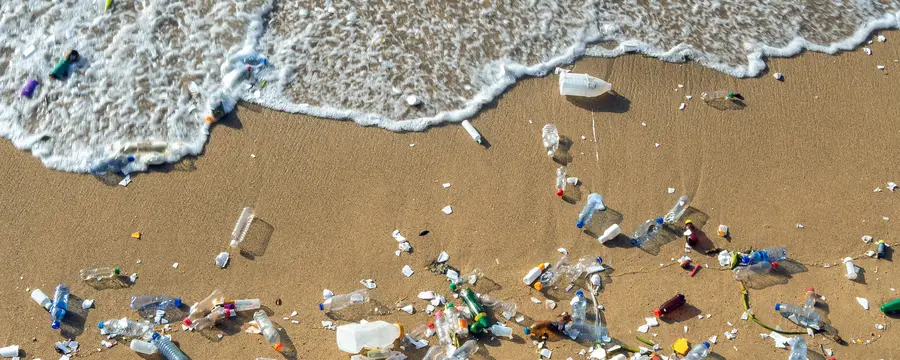
The effect of nano- and microplastics poses a potential risk to human health and is an emerging concern.
The use of plastics throughout the world, while beneficial, has caused large sums of plastic debris to become present in the environment and within biological systems. The effect of these plastics, known as nano- and microplastics, poses a potential risk to human health and is an emerging concern.
Dr. Ninell Mortensen, a research biologist, and Dr. Leah Johnson, a research chemist, recently received the Crossing Boundaries award for their findings on the biological effects of microplastics and nanoplastics as it is related to human health. This award, presented at RTI’s 10th annual Innovation Showcase, highlights work with the greatest potential for impact across scientific disciplines, business units or contexts.
We sat down with Ninell and Leah to learn more about nano- and microplastics, where they are found and what the implications of their presence could be.
Tell us about nano- and microplastics. What is the importance of studying them?
People around the world increasingly rely on plastics, which are key components of many of the items we use every day. Global production of synthetic polymers reached 359 million tons in 2018. Among the most prevalent types of plastics are thermoplastics, found in packaging, toys, and other common products; thermosets, which are used to make carpets, foam, and sponges; and elastomers, which go into car tires and playground turf.
These materials offer many benefits compared to their non-plastic counterparts, but widespread use has resulted in an unforeseen issue. Plastic debris is ending up in the environment and beginning to affect biological systems. And we do not yet understand the potential risks these plastics pose to human health.
When we throw away a plastic container, or any plastic waste, it doesn’t remain in its original form forever. Our research concerns nano- and microplastics—amounts of plastic so tiny that they can be ingested by humans or other animals. Nano- and microplastics originate in two groups: primary and secondary. Primary microplastics (MPs) are intentionally manufactured at a small scale, including microbeads in personal products or pellets that have escaped the production process. Secondary MPs are generated when larger plastic fragments degrade. For example, plastic debris can degrade into micron-scale and nano-scale structures after exposure UV irradiation, heat, mechanical stress, and humidity. The environmental degradation of MPs to produce nanoplastics (NPs) has been demonstrated in laboratory experiments.
The potential risks to human health from the unintentional ingestion of MPs and NPs are an emerging concern. Despite the mounting awareness of small-scale plastics in drinking water, beverages, and food products, little is known about potential downstream effects on biological systems. Furthermore, very few studies currently exist that focus on NPs and smaller sized MPs, which is significant for human exposure given the higher likelihood of smaller-scale particles to cross the intestinal tract.
What was the driving factor in embarking on this research journey?
We started in the field of nano- and microplastic research in 2018 when we wrote a review article about nanoparticles and placental development. We realized a significant knowledge gap concerning nanoplastics and human health and sought to further contribute in this arena. In 2019, we received internal funding at RTI for a joint research and development project, and subsequently a second phase in 2020, which strengthened the momentum of our research, opening new avenues for studies in human health and generating primary data in the field.
What makes RTI uniquely positioned to explore nano- and microplastics?
Given the unique multidisciplinary expertise across RTI, there exist various potential opportunities for involvement, spanning nanotechnology, human health, risk evaluation, policy and regulatory, to name a few. Since the arena of microplastics is relatively new and rapidly evolving, RTI can offer unique capabilities to help better understand these plastic contaminants and offer new solutions.
RTI has established strong momentum in the fast-moving field of nano- and microplastic research and has a unique opportunity to be a leader in the fabrication, detection, and characterization of much needed reference materials needed to move the field of nano- and microplastics forward. Currently polystyrene nanoparticles are the only commercially available nanoplastics, and our recently published report on fabrication of polyethylene terephthalate (PET) nanoparticles with fluorescent tracers is the only known report of well-dispersed PET NP for studies in mammalian systems.
The lack of well-characterized nanoplastics keeps researchers from evaluating the biological interactions between these materials and biological systems to understand the human health risk. RTI has an opportunity to be a key player in these two fields of research: 1) fabrication of references materials, and 2) investigating human health risk of exposure.
Your RTI colleagues honored your microplastics study at the Innovation Showcase, which features promising internally funded research. What was the significance of winning the Crossing Boundaries award?
Winning the Crossing Boundaries award was a great honor and helped increase our momentum to contribute to an emerging field, which has been building rapidly over the last few years. Both the financial and strategic support we have received from RTI has been essential to move our research forward in this fast-past field. A major innovative part of our research is the combination of expertise from researchers in polymer chemistry, analytical chemistry, biology, and toxicology across business units, and RTI’s support of this cross-collaborative endeavor was key.
Where would you like to see the research regarding microplastics go? What are your hopes for the future regarding this arena?
We would like to see the research field of nano- and microplastics move towards a greater understanding of human health impact and risk, particularly for vulnerable populations such as children, pregnant women, and people with underlying health complications. We especially would like to see a focus on nanoplastics and the smallest microplastics, since these are most likely to cause adverse health effects.
However, in order for the field to move in this direction, better and more sensitive nano- and microplastic detection, identification, and characterization methods are needed, since the current methodologies struggle with analyzing microplastics smaller than 5–10 µm. To develop and validate novel methodologies, well-characterized reference materials are needed. That is one of the two knowledge gaps that we already have contributed to fill and are actively working on addressing further.


